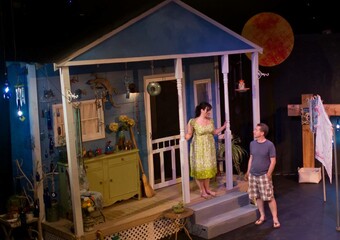Fringe's Frontier
As I carve out time and brain space to write this post, I am flooded with pride for the artists producing independent theatre in DC. There have been many companies that have been “born” through the Capital Fringe Festival, and I feel fortunate to have helped create space for them—their work and their audience. However, even at the moment of inception, Capital Fringe had outgrown our available space.
For a city that is fairly traditional in regards to theatre, developing a culture of producing independent work is incredibly daunting. In the past seven years, the Fringe community keeps growing and creating works that live long after the Festival. It has always been my perspective that the more work that can be created and produced by independent theatre artists/companies outside of the Fringe Festival, the more DC can be a sustainable place for theatre artists to live and work.

For me, every conversation about artistic creation quickly moves to a conversation about space. These are not conversations detailing the need of one company but the need for a collective space, the need for what I like to call a "theatre barn"—think of a movie megaplex, but for theatre. In my vision, this space will be located in one of the two final DC cultural frontiers: the Southwest Waterfront or NOMA/Brookland, and will house five or six stages, all under 140 seats. It will not be run by a producing entity with an artistic mission or a panel of so-called “experts” programming the venues. There will be no resident companies, and the rental rates will be affordable for independent producers, not the common DC metric of the (all-too-expensive) “nonprofit rate.”
The Fringe’s current location, Fort Fringe, where we have built/configured three theatre venues, is continuously being rented by outside companies or being used by the Fringe through the end of 2012. How do we assess the rent for outside companies? We charge them what it actually costs us.
There will be no resident companies, and the rental rates will be affordable for independent producers, not the common DC metric of the (all-too-expensive) “nonprofit rate.”
When Fringe started I knew we needed space, so I went after the largest landowner in our area: Douglas Jemal. Beginning in 2006, I would spend at least an hour or two each week sitting in Doug’s office waiting to talk to him. After a year of watching the fish in his office, I was permitted to talk to his third-in-command, and that year we were able to occupy two of his vacant spaces in Downtown DC. In 2008, I met Doug Jemal in person, then after a tour of the former AV Ristorante Italiano, he said: “do you want it for $5,000 a month?” And the rest, as they say, is history.
It has been quite a journey for Fringe to carve out space in vacant buildings. It is not a sustainable model—the buildings get torn down! What else could we do—it was either too cost-prohibitive to rent, or the newly built and well-equipped regional theatres and arts spaces turned us away because we bring more artists and audiences than they can handle. Yet through this process, our community has demonstrated to us time and again that the Capital Fringe fills a need through providing affordable space without codifying the work.
Fort Fringe will not be standing for that much longer—two years at most. So, what do we do? While wrangling the twelve venues for the 130 productions for this year’s Fringe Festival, I found myself in the basement of a church asking to rent a classroom. I walked around the room briskly then said, “this is fucking ridiculous—seven years in and we are renting church basements.” Then I apologized for swearing in church.
In retelling this story to others, I often heard, “isn’t renting a church basement the Fringe brand?” Each time I replied with a stern, “Is it?!” Does “fringe” mean we are always just going to have to take scraps in terms of space and hustle to make space for thousands of artists each year?
At Capital Fringe we are entering into a year-long planning process. We are surrounded by questions and some answers about our future. Looking out at our city and seeing all the small to mid-size venues turning into restaurants or getting torn down leaves me and so many others with only elbow room to produce independent theatre in DC.
One thing I have learned from the Fringe is you cannot tame the natural energy that a community produces. So, we quest onward toward the final frontiers of the DC landscape. Who will have us?







Comments
The article is just the start of the conversation—we want to know what you think about this subject, too! HowlRound is a space for knowledge-sharing, and we welcome spirited, thoughtful, and on-topic dialogue. Find our full comments policy here
This is a great post, as it speaks honestly about the achievement and the frustration of trying to amp up and make sustainable a hugely important artistic force, while fighting to find conducive space(s) to allow the new works to spring to life. We need exactly what you're suggesting here. Maybe, in the end, a few $5,000 a month spaces, if big enough, will, in fact, be what's necessary to create lots of new arts factories. Again, appreciate your story here. Keep up the important work!